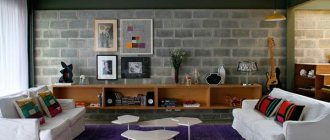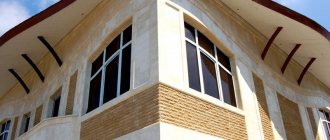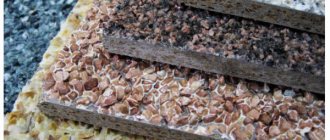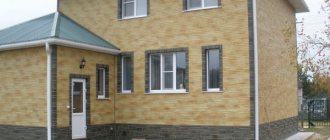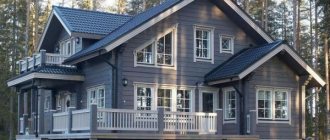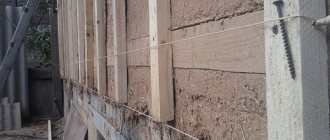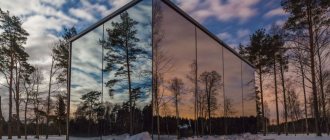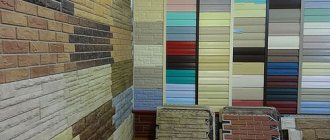Beautiful decoration of the facade of the house with stone and plaster - photo
If at the planning stage you plan to decorate the facade of the house with stone and plaster, the photos on this page will help you choose the best options. And we, together with you, will try to decide why this or that option is better or worse.
Leave your comments on this photo gallery at the bottom of the page. Visitors to our site will participate in the discussion with you.
Advantages of finishing the facade of a house with stone and plaster
Decorative finishing of the facade of the house with stone and plaster, photos of the options of which are presented here, is good because it allows you to solve two issues at once:
- Protects the walls of the house from adverse external influences. This is especially important for walls made of light blocks - aerated concrete and foam concrete.
- Gives walls a decorative look and makes the facade of the house attractive. Agree, it’s better to live in a beautiful house.
This finish looks very “rich” and is perfect for any home with a classic design. The facades of country-style houses that were decorated in this way will also look good.
In general, finishing the facade of a house with stone and plaster, the photo of which you see here, is not suitable for every home. And this is where its disadvantages appear.
Disadvantages of decorating the facade of a house with stone and plaster
Firstly, it is worth noting that plaster as a material will require a stable base. If you decide to plaster a wooden house, then all your efforts will go down the drain - wood “breathes” depending on the humidity and temperature outside.
To plaster a wooden house, you will first have to sheathe it, and then plaster it using reinforcing mesh.
The same applies to the decorative finishing of a wooden house with stone. In order to decorate a wooden house with stone, you will have to carry out extensive preparatory work. It is easier to choose a different facade finishing material for a wooden house.
The second disadvantage of finishing the facade using stone and plaster will be the cost of this method. If you want to make a budget and inexpensive facade, then this method is not for you. If there are a lot of other materials - siding, corrugated board, blockhouse, finishing with which will cost you much less.
Of course, if finances are not a problem for you, then this method – plaster in combination with stone – will make your home visually very attractive.
Preparing the wall
For decorative plaster, the quality of the wall surface is not the most important factor. However, some preliminary work will still have to be done. In order for the coating to last on the wall for a long time, you will need:
- clean the surface of the old coating. It is necessary to remove the wallpaper or layer of paint that was on the wall for this. To make the process easier, we recommend slightly moistening the surface;
- carry out rough alignment. Using regular plaster, it is necessary to eliminate all surface defects. You can use both gypsum and cement mortar. This process will help to significantly save on expensive decorative plaster;
- prime the wall. Priming will increase the level of adhesion and also protect the wall from the formation of mold and mildew. We recommend using all solutions from the same manufacturer;
- limit the work area. Specialists limit the working area using masking tape so that the plaster does not fall on clean walls;
- the work area must be moistened with water. This will improve the properties of the plaster, increase its elasticity and simplify work.
Finishing the facade of the house with stone and plaster - photo gallery
Here are a few photos of finishing the facade of a house with stone and plaster, which shows the best options for using these facade materials.
See how stone and plaster are combined and what solutions are used. Leave your comments on these photos.
See more on this topic on our website:
- Facing brick for the facade - showing finishing options To get a presentable and solid exterior of the building, it is best to choose facing brick for the facade. Photos of finished facades of brick houses can show the options for finishing with brick.
Finishing the facade of a house with stone panels - options and photos The original finishing of the facade of a house with stone panels, the photo of which you see on this page, allows you to obtain a decorative and respectable facade at the lowest cost. Besides.
Cladding the facade of a house in the photo - which material is better So, you choose the materials that can be used to clad the facade of the house. Which material is better? Photos of different facades with different materials used will help you decide this.
The combination of the color of the roof and the facade of the house in the photo If you want to choose the right combination of the color of the roof and the facade of the house, the photos on this page will help you choose the best option. You are absolutely right to pay attention to this.
Technology of finishing different parts of the house with artificial stone For decorating and cladding facades, foundations, basement parts of buildings, as well as for carrying out interior finishing work in modern construction, a large amount of both natural and natural stones is used.
Source: onfasad.ru
Features of the material
The wild stone does not have a beautiful regular shape, but this does not prevent it from attracting the attention of passers-by. Looking at this material, you get the impression that you are in a medieval castle, strong and reliable, in which no enemy is afraid. The photo shows an imitation of natural material, which is not inferior to it in terms of aesthetic characteristics. In order to make this type of decoration available to the general population, a special stone-like plaster was developed. Currently, it is widely used to decorate the basement of houses.
This material contains the following components:
- Quartz, ground to sand;
- Mica ground into dust;
- Various additives that act as dyes give the mixture natural shades of stone
If such plaster is of high quality, non-professionals can hardly distinguish it from natural material.
With its help, you can get an excellent imitation of natural material, saving time and material resources.
Advantages of the material
When carrying out finishing work, preference is given to plaster due to a number of features:
- it is universal, suitable for treating surfaces of any type;
- This coating is distinguished by strength and reliability;
- plaster provides sufficient protection of the walls from precipitation and changes in temperature;
- Construction stores are ready to offer a wide range of materials, differing in color and texture.
The high technical qualities and external characteristics of the coating are confirmed by the photo of the facade finishing with plaster.
Types of plaster
To achieve the desired result, it is important to take a responsible approach to choosing the type of plaster coating. Depending on the base, several types are bottled.
Acrylic (or polymer) plaster coating is elastic and heat-resistant. It is protected from exposure to microorganisms and ultraviolet rays. These features determine its service life of 25 years. The disadvantages of this choice include the high vapor permeability of the material and low resistance to contamination.
In addition to being durable and elastic, silicate is easy to clean. Therefore, finishing the facade with silicone plaster allows the building to provide a decent appearance for 25 years, which is the service life of the coating. But due to low vapor permeability, this variety should not be used together with polystyrene foam.
If the façade is being finished with plaster over insulation, a worthy choice would be to acquire a mineral look. It is considered the most durable and affordable. The main disadvantage is considered to be a fairly short service life, only 10 years.
The final stage of work may be finishing the facade with decorative plaster. It differs from other types in its finer texture, which allows you to implement almost any design ideas, including more expensive types of finishes.
Stone selection
Such a preparatory stage as the choice of decorative stone depends only on the desires and capabilities of the owner of the house.
The easiest way is to make decorative stone yourself, however, the material turns out to be very simple and does not look as rich as a ready-made one.
Depending on the result that needs to be achieved during facade finishing, materials for decoration are selected from the following options:
- Klinenkerny . The stone is made from clay material and has high environmental friendliness and frost resistance. Regarding texture variations, there are a large number of them.
- Concrete cladding . It is considered one of the most affordable options, capable of imitating a large number of rocks and textures. It has durability and high strength.
- Resin based . Natural stone chips are used for production. This type of stone is as close in appearance as possible to natural stone. Features a rich variety of textures.
- Facade . This stone is made of ceramic. In appearance it resembles small bricks and rectangles. To finish the facade, you can only use one that is attached to the surface using a cement base. Otherwise, the duration of operation will be short.
- Polymer sand . It can often be seen used as brickwork. The material is characterized by high resistance to various temperatures and water. It is the most resistant material regarding mechanical damage.
Application rules
Working with the facade of a building involves dependence on the weather. Otherwise the result will be spoiled. So, when plastering walls, temperatures below 5 and above 30 degrees and high humidity should be avoided.
You should not start such work immediately after rain, or if there is a risk of active exposure to sunlight.
If the appropriate conditions exist, you should adhere to the following sequence. First you need to prepare the solution and tools. When applying the coating mechanically, it is worth taking care of scaffolding, scaffolding and hanging cradles.
The first layer is a leveling compound, which is then left to dry completely. Then the surface of the walls must be puttied in order to achieve greater evenness. After the putty has hardened, you need to sand the layer.
The next step is to apply the primer. Decorative plaster is supposed to be applied on top of it. The final stage of work will be applying paint.
Plastering walls with your own hands - wall plastering technology
1) Plastering walls with your own hands begins with waterproofing. Attach the roofing material (in our case, roofing felt) to the wooden wall using nails and a hammer, or using a stapler and paper clips.
2) Lay a layer of steel mesh on top of the roof. Using tin snips, cut the mesh to fit the wall and nail it in place.
3) Using a trowel, apply approximately 1.5cm of plaster directly on top of the metal mesh. If you are applying plaster to a clay wall, you should first brush on a binder (usually gypsum or calcite).
4) Let the coating dry slightly and level the surface with a metal strip; The recommended layer for removal is about 1/3 cm. After this, the plaster should shrink within about 3 days; at the same time, it should be regularly lightly irrigated with water from a garden sprinkler.
5) The technology of plastering walls provides a final layer. To do this, the next step is to apply the final layer of plaster. Its thickness should be approximately 0.5 cm. After this, the process with light irrigation for three days should be repeated.
Additional recommendations for use
In conclusion, it is worth paying attention to some tips that will allow you to complete the job with the highest quality. So, the composition must be applied to the surface in an even layer. Differences in thickness will affect the drying speed of the composition, and will leave a characteristic visual effect.
A prerequisite for good adhesion is compliance with the temperature regime. You should not plaster heavily frozen walls. During the melting process, the applied coating will be destroyed.
Too high a temperature is also undesirable for this type of work. Hot air will speed up the drying process of the solution, which will soon lead to the appearance of cracks.
It is worth remembering that applying plaster is a stage of work that does not allow respite. Continuity of work in this case becomes the key to an even tone of the walls. Therefore, it is necessary to make calculations in advance in order to immediately prepare the required amount of composition. All this will allow you to finish the facade of the house with high quality and reliability.
Source: mojdominfo.ru
Creating an imitation stone finish
The work is carried out on an area of no more than 3 m2, so that the solution does not have time to lose its properties. Depending on the type of work, structuring is done in different ways. Let's look at internal and external processing methods. An interesting version of the walls is shown in the photo below:
Interior decoration
A method called wild stone. The solution is applied to the wall in a small amount and then compacted using a construction trowel. After processing the entire surface, a final layer is applied to the wall, which is then rubbed over. This will help smooth out the surface texture. Then, when the mixture begins to dry, it is rubbed with a grater with strong pressure.
Marmorino technology. Decorative plaster is also applied and then rubbed over. However, in this case, imitation of stone laying occurs due to knocking out with a chisel. The result is a wall covered with rectangles of different sizes. The Marmorino method can be seen in the next photo.
The torn stone technology repeats all the actions of Marmorino, but the knocking out is done in a chaotic manner. As a result, you will get a wall covered with different shapes. Various thicknesses of notches are also allowed.
The technology called small stone is already significantly different from the rest. Here you will need to use a construction trowel, which will create the texture and relief, and then grouting will be done. Grouting is carried out until the shape of small cells is created. In this way, you can achieve a truly high-quality imitation of stone on the walls.
There are also more complex technologies. For example, creating a coating that imitates old stone and then rubbing it with wax. The result of such work will be very unusual and will surprise many of your guests.
External cladding
For exterior work, it is necessary to use a special form, which will help create a relief simulating stone laying. This method is called stamped texture. With this treatment, the coating thickness will be quite large, so the mixture consumption will be increased. The relief will also be in-depth to highlight the effect. There are quite a lot of methods, they allow you to create an imitation of different types of stone. Pay attention to the photo of the wall:
The application method is quite simple, so even a beginner in the construction craft can handle it. A special matrix is placed on the treated surface and held until the solution begins to dry. After creating the relief, the wall must be treated with a stiff metal brush. The result of the exterior finishing can be seen in the following photo.
Finishing the facade of the house with stone in combination with decorative plaster
Thanks to its remarkable decorative and performance characteristics, finishing the façade of a house with stone and plaster is still the most attractive choice. This is a rather complex and time-consuming process associated with the selection of the most optimal materials in terms of quality and price, as well as compliance with cladding technology. Mistakes made during work are difficult to eliminate later and will reduce the expected effect many times over.
Features of façade design with this combination
Stone finishing gives the building a presentable and reliable appearance. Offers made from natural or artificial stone of various shapes, textures, sizes, and colors allow you to choose the best option in terms of price and quality.
Often, in combination with stone, the façade of a house is finished with colored, stone or terrazite plaster. Various techniques of applying material are used, including sgraffito, which allows you to obtain a specific pattern on the facade of the building.
Advantages of facing with stone and plaster
Facing with stone and plaster allows you to:
- hide all defects in the walls, electrical wiring, water pipes and other communications;
- reliably protect the walls of the house from destruction under the influence of mechanical and natural factors;
- maintain the microclimate inside the building;
- increase the fire safety of the building.
The materials are characterized by frost resistance and can withstand sudden temperature changes. Modern plaster compositions are resistant to mechanical damage.
Disadvantages of facing with stone and plaster
Disadvantages of using stone and plaster when decorating a building:
- Requirements for the stability of building walls. “Breathing” walls, for example, made of lumber, will require serious additional work before plastering and facing with stone. Plaster is used for finishing stone and brick walls covered with insulation.
- High cost of work. Natural stone, of course, can be replaced with a cheaper artificial analogue, but the total cost, including cladding and plastering, will not be small.
- Natural stone is a heavy material, which affects loading and unloading and installation. Suitable only for finishing houses that can withstand many kilogram structures.
Areas of application of decorative plaster
This finishing mixture is used for exterior work.
Advice! When using such plaster in interior design, you will not receive either harmony or homely warmth and comfort. We advise you to avoid using stone-like plaster when decorating walls and ceilings.
This finishing material is used in the following situations:
- When plastering the base of a house under stone. Such a solution guarantees an excellent result. The plastered plinth will have excellent aesthetic characteristics, and the cost of the work will be quite reasonable.
- Plastering under the foundation stone. If earlier it was fashionable to build a foundation from untreated stone, now imitation of natural stone is considered popular.
- Plastering stone walls. This kind of decor option is rare, as it is associated with a huge scale of work and serious material and time costs. The result that will be obtained after completing all the finishing work is not always so impressive as to warrant spending money and time on it.
Apply facade plaster under the stone in a fairly thick layer. This is done so that an imprint can be made on the surface, imitating the shape of natural stone. The technology is presented in a short story
Before you start applying the finished mixture to the stone, it is important to carry out full preparatory work.
Attention! The working surface is thoroughly cleaned to achieve a good level of adhesion. Otherwise, you will not be able to achieve high-quality adhesion between the plaster and the surface.
You don’t have to use a primer, it all depends on the condition of the working surface. Often you can limit yourself to just cleaning the surface itself from dust and dirt.
Selection of plaster
For finishing the facade of a building, a composition for external surfaces, the so-called structural plaster, is suitable. It is prohibited to use a textured mixture for cladding.
The following materials have become especially popular in recent years:
- Terrasite plaster is a dry decorative mixture. Its composition sometimes includes marble or granite chips, mica, and various mineral components. Such mixtures allow you to imitate natural stone. Refers to the budget option.
- Acrylic plaster is less susceptible to cracking when the building shrinks.
- High-quality mixtures based on silicate and silicone components, with the best performance characteristics.
Adding color to the putty mixture allows you to give the coating an original shade or effectively combine several colors. The technique of applying the plaster mixture also affects the choice of the plaster mixture. Mixtures containing gypsum are not suitable for sgraffito.
The technique of applying the plaster mixture also influences the choice of plaster mixture. Mixtures containing gypsum are not suitable for sgraffito.
Decorative plaster: composition and advantages
The composition of facade plaster
, which allows you to give the finished surface the appearance of stone, includes:
- Stone chips obtained by grinding natural stone;
- Cement, which is the main binder in the mixture;
- Fine lime, which gives plasticity to the plaster;
- Quartz sand, as well as mica chips, which allow the finish to shine and look realistic;
- Various dyes “responsible” for naturalness.
Advantages of plaster compositions
:
- Suitable as a budget option;
- Easy to apply, light weight;
- Ability to withstand temperature differences and humidity;
- Do not crack or delaminate;
- Do not fade over time, retain their original fresh appearance for a long time;
- Virtually any properly prepared surface can serve as a basis for coating them.
Types and selection of facade stone
Our compatriots relatively recently learned about the existence of artificial finishing stone, which has obvious advantages relative to natural stone, such as lower price, light weight and ease of installation.
Artificial stone is inferior to natural material only in strength characteristics.
The choice of coating is influenced by the quality of the foundation and walls, which must withstand the mass of finishing materials, as well as the coverage area, which affects the weight and cost of the cladding.
In addition to the financial side, two other characteristics of a coating with decorative stone are taken into account: strength and lightness.
Technology of façade finishing with stone and plaster
First of all, plastering work is carried out. They start by preparing the walls (remove the old coating, remove dirt, cover up cracks) and apply a primer. Then a galvanized reinforcing mesh is laid, and lighthouse profiles are attached. The prepared mixture is applied to the walls, and after 15-20 minutes it is leveled with a special tool.
After a day, the beacons are removed and the empty spaces are filled with solution. Then the finishing – decorative layer of plaster is applied.
Stone cladding works:
- Selecting a special polymer-based adhesive. The adhesive must be characterized by high fixation, elasticity, resistance to temperature changes, and high humidity. The optimal drying speed is 1-2 hours, this is enough for adjusting and trimming the stone.
- Preparing the walls. The walls are cleaned of dirt and unnecessary objects, cracks and joints are puttied, and impregnated with primer. A metal mesh is attached to smooth surfaces, which is necessary to hold the adhesive solution.
- Laying stone. Work begins with markings, and the cord is pulled to control the level. The first stone is laid from the corner and from the bottom row. Glue is applied to the wall and to the inside of the stone. The stone is pressed to the base, leaving space for seams. Trimming the material is done with a grinder with a diamond attachment.
- Finishing processing. Involves sealing seams and coating with protective solutions (hydrophobic mixtures).
The use of a water repellent or varnish is mandatory when laying fragile stones, such as slate. No protective work is required for granite or marble.
Features of decorative stone-like plaster compared to decorative stone
- Decorative plaster of this type is light in weight. Therefore, it can be applied without the additional use of mounting grids.
The weight of decorative stone in standard situations also requires installation without additional reinforcement. It is possible to install it yourself by studying, for example, a video course.
- Plaster belongs to the class of decorative coatings with a low price.
Artificial stone is also a finishing material in an affordable price segment.
- Decorative stone-like plaster can be applied not only to the external facade walls of buildings, but also to internal walls. In addition, this type of plaster is applied to fences and steps.
The range of use of decorative stone is in no way inferior to the options for using plaster.
- The use of different forms makes it possible to obtain different textures on the surface of the walls. For example, the shape can imitate ancient bricks, large stones, etc.
Currently, the market offers a wide range of decorative stones: textures, colors, types.
- Decorative plaster can be used on any type of wall and, at the same time as having a decorative function, solve the problem of a leveling mixture. If a leveling effect is needed, the plaster is applied in two layers. The first layer is for leveling, the second layer is for texture.
- Plaster can be applied to surfaces either manually or by machine. The speed of surface formation is quite high, which makes the application process not very expensive.
Installation of stone does not require qualifications; in addition, convenient sizes and finished texture are competitive advantages over plaster.
- Plaster can be used as a finishing coat. But in some cases, another layer of a special composition is applied to the surface, which creates an imitation of an ancient wall. The so-called process of material aging occurs.
Decorative stone also serves as a decorative finish.
- Stone-like plaster tolerates temperature changes, direct sunlight, and moisture well. Such high characteristics are due to the fact that high-quality cement is used as a binder.
According to experience, the performance characteristics of decorative stone exceed the strength and durability of plaster.
- Decorative stone-like plaster is not prone to delamination and cracking (as a rule).
Under extreme impact (strong impact, thermal impact, long-term exposure to water, etc.), defects are possible on both types of materials.
Decorating the facade of a house with decorative stone and plaster - ideas in the photo
The facade of a building is its “face”. A beautiful house is the pride of the owner and the decoration of the street. At the same time, the decoration of the facade plays not only a decorative role, but also a protective one. There are many types of cladding, but the most common is the design of facades with decorative plaster and stone. Photos of finishing options will help create a general idea of your future home.
Houses have been decorated with plaster and stone for many years. This beauty is available to everyone if you entrust the matter to professionals.
Despite the fact that plaster provides little sound insulation, it is still popular today.
Stone masonry much better protects the surface of the house from mechanical damage and environmental influences.
Cladding with artificial stone increases the service life of the building, and therefore you will not have to think about repairs soon.
Modern designers skillfully combine plastered walls with stone trim.
Houses with the lower part lined with stones and the upper part plastered look impressive.
With the help of plaster and decorative stone you can create real masterpieces.
Artificial stone goes well with other types of facade decoration.
Stone-clad houses turn into miniature castles.
With the help of modern materials, you can turn your home into a real work of art, the main thing is to show your imagination.
Source: fasad.guru
Functions and types of facade finishing
When choosing a façade finish at the construction stage or during the renovation of a house, in addition to its decorative role, you should pay attention to the performance of protective functions. Basic conditions that finishing materials for external walls must meet:
- Durability over a long period of time.
- Resistance to negative environmental factors. The complex concept includes exposure to moisture, significant temperature changes, and the possibility of mold growth.
- Fire safety.
- Improving thermal insulation qualities.
- Maintaining an attractive appearance for a long period.
Let's leave aside modern options for decorating the facades of private houses using siding or sandwich panels and pay attention to traditional methods in the form of finishing with stone or applying decorative plaster.
Facade stone for decorating external walls can be of natural or artificial origin. When choosing a natural stone, the species plays a key role; the properties of the finishing material depend on it. The characteristics of a decorative stone depend on the composition from which it is made. The appearance of the finish is influenced by the mineral or rock that is imitated by artificial stone.
Also, when choosing stone as a finishing material, you need to be aware of the difference between two polar concepts such as “stone cladding” and “masonry”. In the first case, this refers specifically to the exterior decoration of the house, the walls of which are made of concrete, brick or wood. The second concept implies the full construction of stone walls of a private house.
Finishing of facades of private houses with photos and materials for cladding
Materials for finishing facades must be thought out at the stage of designing a house. The appearance of the future building should fit perfectly into the landscape design, be neat and beautiful. Facade finishing performs several important functions:
- decorative;
- solves the issue of sound insulation;
- serves as insulation for the house.
All material must be durable, resistant to external irritants and tolerate climatic conditions well. In this article we will analyze in detail which cladding products are best used for external work and will reveal all the advantages and disadvantages of each.
Types of finishing materials
The modern construction market offers a lot of products for facade work. The most common products among buyers are:
- porcelain stoneware;
- decorative plaster;
- tiles or clinker bricks;
- siding;
- sandwich panel;
- natural or artificial stone;
- façade cassettes.
All presented finishing materials for the facades of private houses have their own advantages and disadvantages, and also differ in pricing policy. Therefore, to choose the right product, you need to calculate their cost and take into account all the advantages. Thanks to finishing facade materials, specialists solve several problems, such as:
- unevenness of the structure;
- possible geometric errors;
- wear and dilapidation of the façade of the building;
- additional insulation;
- decorative improvement and improvement of appearance.
Full characteristics of facade products
Porcelain tiles
Porcelain stoneware is one of the best solutions for cladding the façade of a building. The product range is rich in colors and shapes, although you won’t be able to apply a design on it. The rainbow look of porcelain tiles looks especially attractive. Manufacturers also produce porcelain tiles in the form of wood or stone; this material looks natural and natural. The main properties of this material:
- has high strength and long service life;
- resistant to mechanical damage;
- has high moisture resistance, the structure of the product does not absorb water, due to this, cracks do not form on the surface and frost is well tolerated;
- It is resistant to any temperature conditions; it is also worth noting that porcelain stoneware does not burn;
- has a stable color and does not fade in the sun;

